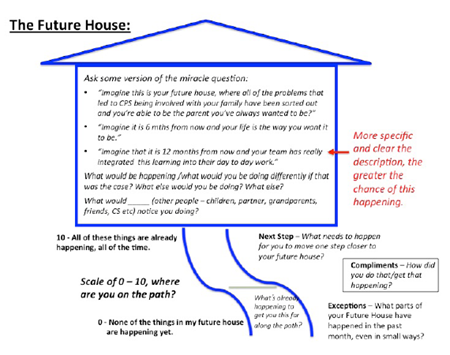The Framework for Practice tools can be adapted to help engage carers and the carer household. Some tools are listed in the following paragraphs, along with a description of how and when you may find them beneficial.
The Three Houses Tool
The Three Houses Tool involves both drawing and words and is an effective tool to help children express in drawings their worries, what makes them happy and what they would like from their care arrangement.
The children don’t have to use houses as a basis of this tool, and it could be any symbol or drawing that will help them connect, such as a teddy bear, a fairy or a favourite television or movie character.
The Immediate Story
The Immediate Story is a great tool to use when children are entering a care arrangement, to help reduce the impact of trauma and share information in a simple yet meaningful way so they understand as much as possible about what is happening. The Immediate Story provides an explanation to the child about the reason for the care arrangement, about what is happening now or has just happened (for example, the child being moved from their parent’s care and going to stay with other family members or foster carers), and what is going to happen next.
This tool is also beneficial for the carer’s own children when new children are entering their family home at the start of a care arrangement, or perhaps when a sudden change of care arrangement occurs and the carer’s children experience a loss.
Circles of Safety and Support Tool
The Circles of Safety and Support Tool may be helpful when exploring the social support network for carers. The safety and support network of a carer is just as important as a child’s safety and support network in that it forms the ‘village’ around the child in care.
It may be made up of people such as extended family, friends and community members who will work with the carers and involved professionals to develop and maintain a plan to ensure the child’s long-term safety, belonging and wellbeing are met during the care arrangement.
The network also provides support to the carers, with people with whom the carer can debrief confidentially, as well as the network that provides babysitters for the children (among other support strategies).
The Family Roadmap
As discussed earlier, The Family Roadmap is a great tool to use with the carer household and age-appropriate children. It may be useful when unpacking problems that may be leading to a change of care arrangement or even when children are refusing to return to a care arrangement.
It is used to engage the family—not just one person specifically. It identifies what family life is at its best and at its worst, and then helps the family to see what strengths and resources they already have in place to build the family up and work towards life at its best again.
Published on:
Last reviewed:
-
Date:
Maintenance
-
Date:
Maintenance
-
Date:
Maintenance
-
Date:
Terminology change - placement to care arrangement
-
Date:
Maintenance.
-
Date:
Page created



